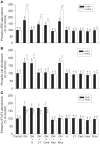ERK, Akt, and STAT5 are Differentially Activated by the Two Growth Hormone Receptor Subtypes of a Teleost Fish (Oncorhynchus Mykiss)
- PMID: 22649371
- PMCID: PMC3355939
- DOI: 10.3389/fendo.2011.00030
ERK, Akt, and STAT5 are Differentially Activated by the Two Growth Hormone Receptor Subtypes of a Teleost Fish (Oncorhynchus Mykiss)
Abstract
Previously, we found that the teleost fish, rainbow trout, possesses two growth hormone receptor (GHR) subtypes that display distinct ligand-binding and agonist-induced regulation features. In this study, we used Chinese hamster ovary-K1 cells stably transfected individually with the two trout GHR subtypes, GHR1 and GHR2, to elucidate receptor-effector pathway linkages. Growth hormone (GH) stimulated rapid (5-10 min) phosphorylation of ERK, Akt, JAk2, and STAT5 in both GHR1- and GHR2-expressing cells; however; STAT5 was activated to a greater extent through GHR1 than through GHR2, whereas ERK and Akt were activated to a greater through GHR2 than through GHR1. Although blockade of the ERK pathway had no effect on the activation of Akt, inhibition of PI3K-Akt partially prevented activation of ERK, suggesting cross-talk between the ERK and PI3K-Akt pathways. JAK2 inhibition completely blocked activation of ERK, Akt, and STAT5, suggesting that all of these pathways link to GHR1 and GHR2 via JAK2. These findings establish important receptor-effector pathway linkages and suggest that the GHR subtypes of teleost fish may be functionally distinct.
Keywords: LY294002; U0126; growth hormone; signal transduction.
Figures




References
-
- Argetsinger L. S., Carter-Su C. (1996). Mechanism of signaling by growth hormone receptor. Physiol. Rev. 76, 1089–1107 - PubMed
-
- Bjornsson B. T., Johansson V., Benedet S., Einarsdottir I. E., Hildahl J., Agustsson T., Jonsson E. (2004). Growth hormone endocrinology of salmonids: regulatory mechanisms and mode of action. Fish Physiol. Biochem. 27, 227–24210.1023/B:FISH.0000032728.91152.10 - DOI
LinkOut - more resources
Full Text Sources
Molecular Biology Databases
Miscellaneous

